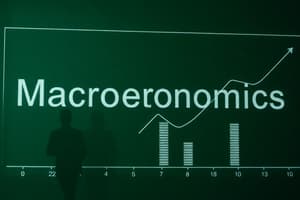Podcast
Questions and Answers
What is the primary focus of economics?
What is the primary focus of economics?
- Studying consumer behavior exclusively
- Understanding financial markets over time
- How to allocate scarce resources (correct)
- Maximizing profits for businesses
Which branch of economics looks at the overall economy?
Which branch of economics looks at the overall economy?
- Development Economics
- Microeconomics
- Behavioral Economics
- Macroeconomics (correct)
What does opportunity cost represent?
What does opportunity cost represent?
- The average cost of all choices made
- The financial cost of a decision
- The benefit of the most valuable alternative given up (correct)
- The total cost of all alternatives
In which market structure does a single firm dominate the market?
In which market structure does a single firm dominate the market?
What does GDP stand for?
What does GDP stand for?
What is an effect of expansionary fiscal policy?
What is an effect of expansionary fiscal policy?
What characterizes a market economy?
What characterizes a market economy?
What is the purpose of monetary policy?
What is the purpose of monetary policy?
Flashcards are hidden until you start studying
Study Notes
Key Concepts in Economics
1. Definition of Economics
- The study of how individuals, businesses, and governments allocate scarce resources.
- Focuses on decision-making and resource management.
2. Major Branches of Economics
- Microeconomics: Examines individual units, such as households and firms, and their interactions.
- Macroeconomics: Analyzes the economy as a whole, focusing on aggregated indicators like GDP, unemployment, and inflation.
3. Basic Economic Principles
- Supply and Demand: Determines market prices; supply represents how much of a good is available, while demand reflects how much consumers want.
- Opportunity Cost: The cost of the next best alternative foregone when making a decision.
- Marginal Analysis: Evaluates the additional benefit versus the additional cost of a decision.
4. Market Structures
- Perfect Competition: Many firms, homogeneous product, no barriers to entry.
- Monopoly: Single firm controls the market, significant barriers to entry.
- Oligopoly: Few firms dominate the market, products may be homogeneous or differentiated.
- Monopolistic Competition: Many firms sell similar but not identical products.
5. Economic Indicators
- Gross Domestic Product (GDP): Total value of goods and services produced in a country.
- Inflation Rate: The percentage increase in prices over a specified period.
- Unemployment Rate: The percentage of the labor force that is unemployed and actively seeking work.
6. Fiscal Policy
- Government policy regarding taxation and spending to influence the economy.
- Expansive fiscal policy (increased spending or tax cuts) aims to stimulate growth.
- Contractionary fiscal policy (decreased spending or tax increases) aims to reduce inflation.
7. Monetary Policy
- Conducted by central banks to manage the money supply and interest rates.
- Expansionary: Lower interest rates, increase money supply to encourage borrowing and investment.
- Contractionary: Raise interest rates, decrease money supply to curb inflation.
8. Types of Economic Systems
- Market Economy: Decisions based on supply and demand; minimal government intervention.
- Command Economy: Central authority makes economic decisions; government controls resources.
- Mixed Economy: Combines elements of both market and command economies.
9. International Economics
- Trade: Exchange of goods and services between countries; influences on comparative advantage.
- Foreign Exchange Market: Determines the value of currencies, affecting international trade.
10. Key Terms
- Elasticity: Measure of responsiveness of quantity demanded or supplied to changes in price.
- Consumer Surplus: Difference between what consumers are willing to pay and what they actually pay.
- Producer Surplus: Difference between what producers are willing to accept and what they receive.
Conclusion
Economics provides essential insights into the behavior of individuals and markets, guiding decision-making at all levels. Understanding its key concepts is vital for analyzing both microeconomic and macroeconomic conditions.
Definition of Economics
- Economics studies how individuals, businesses, and governments allocate scarce resources.
- It emphasizes resource management.
Major Branches of Economics
- Microeconomics focuses on individual units like households and firms and their interactions.
- Macroeconomics studies the economy as a whole, focusing on overall indicators like GDP, unemployment, and inflation.
Basic Economic Principles
- Supply and demand dictate market prices.
- Supply represents the amount of a product available.
- Demand represents consumer desire for the product.
- Opportunity cost is the value of the next best alternative when making a decision.
- Marginal analysis evaluates the additional benefit versus the additional cost of a decision.
Market Structures
- Perfect Competition: Numerous firms offering identical products with unrestricted entry.
- Monopoly: Single firm controls the market with high barriers to entry.
- Oligopoly: Few firms dominate the market, potentially offering similar or differentiated products.
- Monopolistic Competition: Many firms sell similar but not identical products.
Economic Indicators
- Gross Domestic Product (GDP): Total value of goods and services produced in a country.
- Inflation Rate: Percentage increase in prices over a specific period.
- Unemployment Rate: Percentage of the labor force that is actively seeking work but is unemployed.
Fiscal Policy
- Government policies that influence the economy using taxation and spending.
- Expansive fiscal policy (increased spending or tax cuts) stimulates economic growth.
- Contractionary fiscal policy (decreased spending or tax increases) controls inflation.
Monetary Policy
- Central banks implement monetary policy to manage money supply and interest rates.
- Expansionary Monetary Policy: Lowers interest rates and increases the money supply. This motivates borrowing and investing.
- Contractionary Monetary Policy: Increases interest rates and decreases the money supply. This aims to curb inflation.
Types of Economic Systems
- Market Economy: Supply and demand drive economic decisions, with minimal government intervention.
- Command Economy: A central authority controls resources and makes economic decisions.
- Mixed Economy: Combines elements of both market and command economies.
International Economics
- Trade: Exchange of goods and services between countries, influenced by comparative advantage.
- Foreign Exchange Market: Determines the value of currencies, impacting international trade.
Key Terms
- Elasticity: Measures the responsiveness of quantity demanded or supplied to price changes.
- Consumer Surplus: Difference between what consumers are willing to pay and the actual price they pay.
- Producer Surplus: Difference between the price producers are willing to accept and the price they actually receive.
Studying That Suits You
Use AI to generate personalized quizzes and flashcards to suit your learning preferences.




